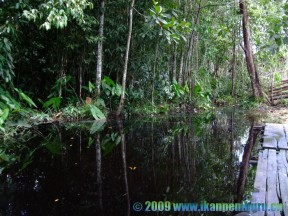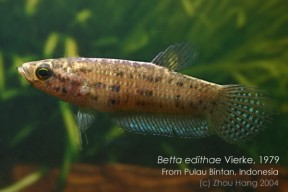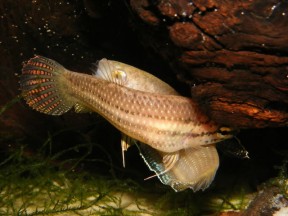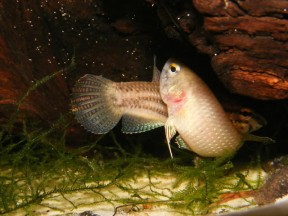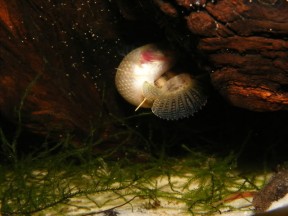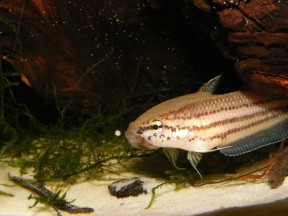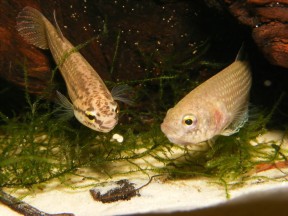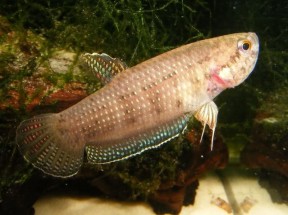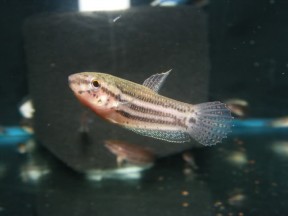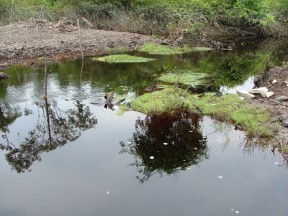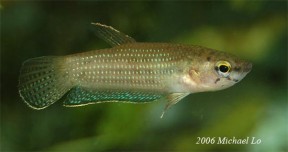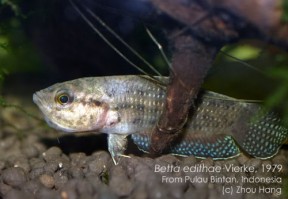Betta edithae
Etymology
edithae: named for Edith Korthaus who was involved in the discovery of this species and many other fishes from Borneo.
Classification
Order: Perciformes Family: Osphronemidae
Distribution
This species is known only from the Greater Sunda Islands region in Indonesia.
Type locality is ‘Barito River delta, Banjarmasin, Borneo Indonesia’ which corresponds to the town of Banjarmasin in South Kalimantan (Kalimantan Selatan) province.
It’s subsequently been recorded over a large range including all four provinces of Kalimantan as well as near Palembang in South Sumatra (Sumatera Selatan) province, Sumatra and the islands of Bangka, Belitung (together forming Bangka-Belitung province) and Bintan (Riau Islands province).
It remains unclear whether all the populations are conspecific or not, with fish from Bintan differing from Bornean specimens in several characters (see ‘Notes’), while those from Palembang resemble the population from Bangka.
Habitat
Found in various habitat-types from flowing, black water streams where it tends to inhabit stiller, marginal areas among submerged roots, leaf litter or overhanging vegetation, to sluggish, artificially-modified canals inside oil palm plantations.
Maximum Standard Length
55 – 60 mm.
Aquarium SizeTop ↑
An aquarium with base measurements of 80 ∗ 30 cm should be the minimum considered.
Maintenance
This species does best in a well-planted, shady tank with plenty of surface cover in the form of tall stem plants, floating types such as Salvinia or Riccia spp. or tropical lilies from the genus Nymphaea.
Cryptocoryne spp. are also a good choice and will cope with the dim conditions.
Driftwood can also be used and other plants such as Microsorum or Taxiphyllum spp. can be attached to it. Small clay plant pots, lengths of plastic piping or empty camera film cases can also be included to provide further shelter.
The addition of dried leaf litter provides additional cover and spawning sites, and brings with it the growth of beneficial microbe colonies as decomposition occurs.
These can provide a valuable secondary food source for fry, while the tannins and other chemicals released by the decaying leaves aid in simulation of natural conditions. Alder cones may also be used for the latter purpose.
There is no need to use peat, the collection of which is both unsustainable and environmentally-destructive.
As it naturally inhabits sluggish waters filtration should not be too strong, with an air-powered sponge filter set to turn over gently adequate.
Keep the tank well-covered and do not fill it to the top as like all Betta spp. it requires occasional access to the layer of humid air that will form above the water surface, and is an excellent jumper.
Water Conditions
Temperature: 20 – 27 °C
pH: 5.0 – 7.0
Hardness: 18 – 90 ppm
Diet
Likely to prey on insects plus other small invertebrates zooplankton in nature.
Captive fish will normally accept dried products once they’re recognised as edible, but should be offered plenty of small live or frozen foods such as Daphnia, Artemia and bloodworm on a regular basis.
Small insects such as crickets or Drosophila fruit flies are also suitable to use; it’s best to fill the stomachs of these by feeding them fish flakes or some kind of vegetable matter before offering them to the fish.
Take care not to overfeed as Betta spp. seem particularly prone to obesity.
Behaviour and CompatibilityTop ↑
Not recommended for the standard community set-up for reasons already touched upon.
It’s requirements and disposition mean it’s best kept alone or with very peaceful species since much bigger or more vigorous fishes are likely to intimidate and outcompete it.
Some small cyprinids and loaches that inhabit similar environments in nature are compatible but be sure to research your choices thoroughly.
It can be maintained in a pair or group and will display some interesting behavioural interactions under the latter circumstances.
Sexual Dimorphism
Males grow larger, possess a greater amount of iridescent scaling on the head, a broader head shape, and more extended fins than females.
Reproduction
Paternal mouthbrooder.
Ideally organise a separate tank for breeding purposes, unless the fish are already being maintained alone, setting this up as suggested above.
The tank should have the tightest-fitting cover you can find (some breeders use clingfilm instead to ensure no gaps) as the fry need access to a layer of warm, humid air without which development of the labyrinth organ can be impaired.
Following a protracted courtship, eggs and milt are released during an ’embrace’ typical of osphronemids in which the male wraps his body around that of the female.
Several ‘dummy’ embraces may be required before spawning commences.
Fertilised eggs are caught on the anal-fin of the male then picked up in the mouth of the female before being spat out into the water for the male to catch.
Once the male has all the eggs in his mouth the cycle is repeated untill the female is spent of eggs, a process which can take some time.
A brooding male may swallow or release the eggs prematurely if stressed or inexperienced, so it’s preferable to leave the female and any other fishes in situ.
The incubation period is 9-16 days at the end of which the male will begin to release fully-formed, free-swimming fry.
At this point they can be removed or left to grow alongside the parents, though some may be lost to predation under the latter circumstances.
The fry are large enough to accept motile foods such as microworm and Artemia nauplii immediately, though it should be noted that there exist reports of young Betta developing health issues if fed excessive amounts of the latter.
Offer small amounts of different foods 2 -3 times per day for optimal growth rate, and don’t change too much water at once, with regular, small changes preferable to intermittent larger ones.
NotesTop ↑
This species is the only member of the B. edithae group within the genus and is separated from all other Betta spp. by the fact that the branchiostegal membrane and posterior portion of the opercle are opaque or translucent.
The original diagnosis by Vierke also states that it has relatively small eyes and short fins with a typical pattern of partial barring while Witte and Schmidt (1992) mention the presence of ‘delicate semicircular bars’ in the fins of males, these being replaced by rows of spots in females, and an additional fourth lateral stripe in the upper body of adults.
Fish from Bintan Island differ from Bornean specimens in having an interrupted chin bar or chin bar joined centrally by thin black mark, plus the chin bar is rounded towards the throat (vs. uninterrupted chin bar without rounded ends).
In addition they have a greater preanal length (48.2-51.8 % SL vs. 45.6-47.2 %) and apparently a smaller adult size (largest specimen recorded 40 mm SL vs. 55 mm SL).
The genus Betta is the most speciose within the family Osphronemidae with almost 70 recognised members and looks set to grow further with new ones continuing to be described on a regular basis since the turn of the century.
Member species have successfully adapted to inhabit a variety of ecological niches from stagnant ditches to flowing hill streams including some extreme environments such as highly acidic peat swamp forests.
The referral of members to a number of groups containing closely-related species is now generally accepted but largely based on morphological and behavioural characters.
Molecular phylogenetic work may therefore prove useful in more precisely determining relationships between these fishes.
A full list of the species groups as currently recognised can be found here.
Like others in the suborder Anabantoidei this species possesses an accessory breathing organ known as the labyrinth.
So-called due to its maze-like structure this organ allows the fish to breathe atmospheric air to a certain extent.
Comprising paired suprabranchial organs formed via expansion of the epibranchial (upper) section of the first gill arch and housed in a chamber above the gills, it contains many highly-vascularised, folded flaps of skin which function as a large respiratory surface.
Its structure varies in complexity between species, tending to be better-developed in those inhabiting harsher environments.
References
- Vierke, J., 1984 - Aquarium Aqua Terra 18(176): 58-63
Betta taeniata Regan, 1910 und Betta edithae spec. nov., zwei Kampffische von Süd-Borneo. - Roberts, T. R., 1989 - Memoirs of the California Academy of Sciences No. 14: i-xii + 1-210
The freshwater fishes of western Borneo (Kalimantan Barat, Indonesia). - Tan, H. H. and P. K. L. Ng, 2005 - Raffles Bulletin of Zoology Supplement (13): 43-99
The fighting fishes (Teleostei: Osphronemidae: Genus Betta) of Singapore, Malaysia and Brunei. - Tan, H. H. and P. K. L. Ng, 2005 - The Raffles Bulletin of Zoology Supplement 13: 115-138
The labyrinth fishes (Teleostei: Anabanatoidei, Channoidei) of Sumatra, Indonesia. - Witte, K.-E. and J. Schmidt, 1992 - Ichthyological Exploration of Freshwaters 2(4): 305-330
Betta brownorum, a new species of anabantoids (Teleostei: Belontiidae) from northwestern Borneo, with a key to the genus.

